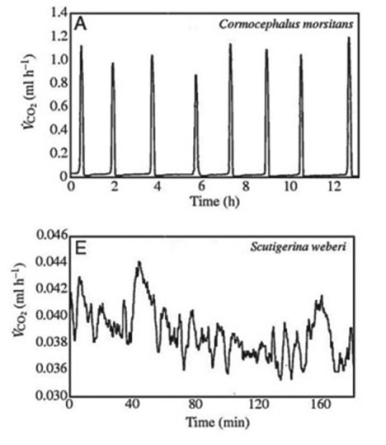Use the following information and figures to answer the question.
Many terrestrial arthropods exchange gases with their environments by using tracheae, tubes that lead from openings (called spiracles) in the animal's exoskeleton or cuticle directly to the animal's tissues. Some arthropods can control whether their spiracles are opened or closed; opening the spiracles allows the carbon dioxide produced in the tissues to travel down the tracheae and be released outside the animal. Klok et al. measured the carbon dioxide emitted over time (represented by ⱽCO₂) by several species of centipedes. The figures present graphs of their results for two species, Cormocephalus morsitans and Scutigerina weberi.
How would a terrestrial centipede most likely benefit from the ability to close its spiracles? Closing spiracles would ________.
Definitions:
Bluetooth Connection
A wireless technology standard for exchanging data over short distances between electronic devices.
Encrypted Files
Digital documents that have been converted from a readable form to an encoded version that can only be decrypted and understood by those who have the necessary decryption key.
Network Attached Storage
A dedicated file storage device connected to a network, allowing multiple users and client devices access to shared data.
Wireless Network Keys
Security codes used to access encrypted Wi-Fi networks, protecting them from unauthorized use.
Q1: A trend first observed in the evolution
Q15: Muscle cells are organized to perform specific
Q29: There are advantages and disadvantages to adaptations.
Q42: What is the goal of bioremediation?<br>A) to
Q50: A mineral deficiency is likely to affect
Q62: The adaptive advantage associated with the filamentous
Q64: Arthropod exoskeletons and mollusc shells both _.<br>A)
Q65: Use the figure to answer the question.<br><img
Q69: If all fungi in an environment that
Q74: A botanist discovers a new species of